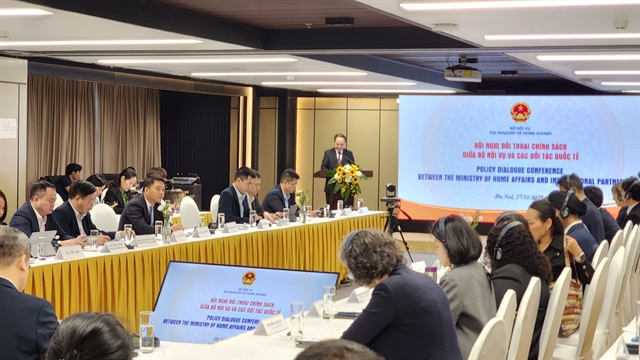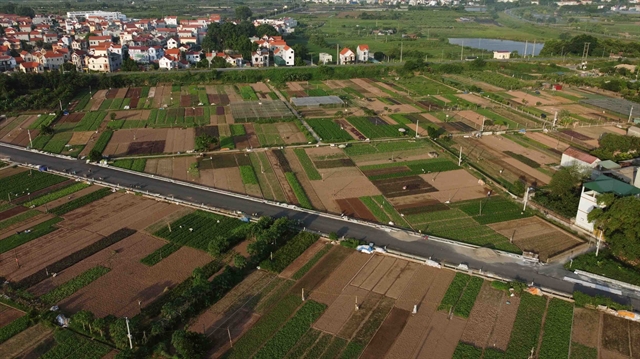 Society
Society


|
| Fields grow safe fruit, vegetables and tubers in Tiền Yên Commune, Hoài Đức District, Hà Nội. — Photo courtesy of the Hà Nội Agricultural, Forestry and Fisheries Quality Management Division |
HÀ NỘI — Hà Nội’s agricultural sector has been focusing on minimising the use of chemical pesticides and replacing them with biological pesticides, towards an agricultural sector that is safe, sustainable and environmentally friendly.
The move aims to create a source of clean vegetables and fruit with clear origin to serve domestic consumption and export.
Nguyễn Tiến Cường, Chairman of the Farmers' Association of Khai Thái Commune, in Phú Xuyên District, said the commune has instructed local farmers to grow water celery in a total area of 35ha to build the brand name of Khai Thái Water Celery.
The water celery is grown following a safe and environmentally friendly process, he said.
Thanks to the process, farmers earn about VNĐ700-900 million (US$29,900-38,500) per ha of water celery, he said.
The Khai Thái water celery was granted a Certificate of Collective Trademark Registration by the Intellectual Property Office of Việt Nam, under the Ministry of Science and Technology.
The water celery was also recognised as a four-star product of the One Commune-One Product (OCOP) Programme, he said.
Bùi Thị Thanh Hà, director of Thanh Hà Agricultural Service and Production Cooperative in Thường Tín District, said the co-operative has applied hi-tech to plant vegetables to meet the criteria of safe products.
The vegetables are grown in a closed chain on an area of 1.15 ha in the district, he said.
All products of the co-operative are affixed with QR codes. Currently, every day, the cooperative supply nearly one tonne of vegetables, tubers and fruit to the market, he said.
Nguyễn Anh Dũng, deputy chairman of the People’s Committee of Đông Anh District, said the district has disseminated information to raise the awareness of producers in limiting the use of chemical pesticides in growing vegetables.
Currently, the number of chemical pesticides used in growing vegetables has decreased by about 15 per cent compared to previous years, he said.
Farmers have used biological fertilisers to meet the criteria of food safety, he said.
Nguyễn Thị Thu Hằng, Director of the Hà Nội Agricultural, Forestry and Fisheries Quality Management Division said safe production areas not only create a source of clean and clear-origin food but also bring higher income for farmers.
Their income is estimated to be about 15–20 per cent higher than normal, she said.
Safe production areas also help limit environmental pollution, she added.
Hà Nội now has over 200 rice production areas, covering more than 5,000 ha.
Challenges and solutions
Safe agricultural production has brought high economic efficiency. However, there are still difficulties.
For example, agricultural production is still deployed on a small scale and lacks linkages. Infrastructure, roads and irrigation have not been synchronised.
Hoàng Văn Thám, director of Chúc Sơn Clean Vegetable and Fruit Co-operative in Chương Mỹ District, said the city’s agricultural sector needs to operate trading floors, specialising in safe agricultural products to create linkages among producers, cooperatives with consumers.
To promote the consumption of clean and clear-origin fruit and vegetables, the sector should have dissemination plans so that consumers will trust and change their perception of the consumption of agricultural safe products, he said.
Phạm Văn Hoạch, head of the Economic Office of the People’s Committee of Ứng Hòa District, said the district will promote the consumption of safe fruit and vegetables by creating more linkages and building typical products for each locality to participate in the OCOP Programme.
Chu Phú Mỹ, director of the Agricultural and Rural Development Department, said Hà Nội will invest in developing large-scale concentrated safe agricultural areas in the coming time.
It will also improve production infrastructure associated with branding and supporting output for safe agricultural products, he said.
For fruit trees, it will focus on developing specialised-cultivation areas following key tree groups such as grapefruit, banana and longan, with a scale of more than 20,000 ha, he said. — VNS




